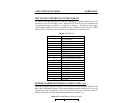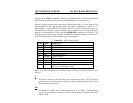
MFJ-1278B MULTI-MODE TROUBLESHOOTING
Step 4: Cabling Problems
Inspect the interconnection cabling. Does it work on another TNC? Has the radio and/or
terminal been successfully used on packet with this or another TNC? Are all the connections
tight? Has the cable frayed or broken?
SPECIFIC SYMPTOMS
While the steps described above may seem obvious, careful inspection often will point to the
problem or give significant clues as to the probable area of the MFJ-1278B most suspect.
After the above inspection has been completed and apparent problems are dealt with, it is
time to proceed to more specific analysis.
Symptom: TNC appears dead
If the MFJ-1278B powers up with the PWR, STA, and CON LEDs lit, followed by STA and
CON extinguishing a second or so later, the processor is working and the software is
probably working correctly. You should suspect the RS-232C serial port at this point. Check
all connections and verify the logic levels according to the terminal interface troubleshooting
section in this chapter.
Oscillator and Reset Circuits
If no LEDs wink during the reset cycle the problem may be more serious. Check to see that
the crystal oscillator is working and that an "M1" signal (154 kHz square wave, 0 to +5 volts)
is coming from U22 pin 27. The crystal oscillator input to the processor (U22) is pin 6. The
input clock should be a (possibly distorted) square wave signal. Verify that the clock input at
pin 6 of U22 is running at the correct frequency (near 4.9152 MHz).
Verify that the battery backed-up RAM protection circuit, composed of Q4, U14 and
associated devices, is going to +5 volts at U14 pin 6 after input power is applied. This signal
enables normal operation of U24 and U25. There should be a logical low on the output of
U7 pin 12 coincident with the application of power and lasting for a few hundred
milliseconds. Without this RESET signal, the Z80 probably won't start up properly.
Digital Logic Lines
Remember that all the logic circuits operate at standard TTL levels (a "low" is less than +0.8
V and a "high" is greater than +2.4 volts), and all digital inputs and outputs switch between
these two levels. Thus, if you see logic signals switching between 0 and, say, 1 volt, you can
be sure there is a problem (usually a short). On the other hand, do not mistake switching
transients on digital logic lines for improper operation -- these show up as ringing and other
distortions.


















